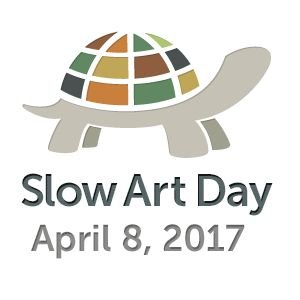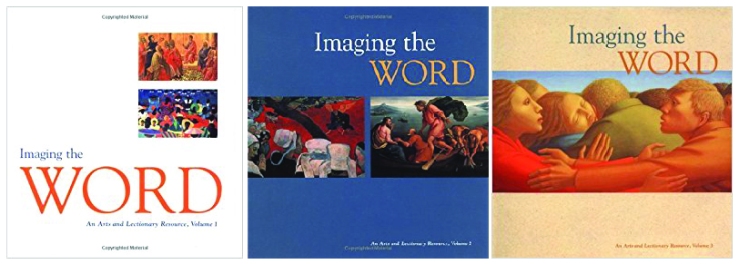Our digital age has taught us to consume content quickly rather than thoughtfully. Even fine art. People can go to a museum, spend hours looking at hundreds of works, rushing through all the galleries, and walk out exhausted, not really having seen anything. I am ashamed to say that this has sometimes been my approach. I’m traveling, I pay a $15 admission fee to the local art museum, and I have three hours to explore; to get the most out of my money, I figure, I want to see as much as possible within that time frame. Where permitted, I snap photos of the pieces I want to spend more time with later when I get home—but then they’re just pixels. I miss out on experiencing their materiality.
The same principle is often at play with buffets too: we pay a set price for access to a variety of foods, so naturally, we want to sample a little bit of everything, overstuffing ourselves so we can feel like we took full advantage of the “unlimited” perk. But as my wise mother says: You’re not paying to feel stuffed; you’re paying to feel satisfied. Go ahead and survey the spread, maybe try a spoonful of whichever dishes look enticing, but then go back for those few that you want a heartier helping of. That’s when you can really savor what you’re eating.
My mom’s advice translates well, I think, to museum going.

In 2008 art-world outsider Phil Terry discovered how nourishing, how energizing, it can be to actually spend time with a work of art for more than the standard eight seconds. In 2009 he officially launched Slow Art Day, a global, annual event whose mission is to help people discover the joy of looking at and loving art. It’s set for April 8 this year—a week from Saturday. The concept is simple: Go to a museum or gallery, look at five different works of art for ten minutes each, and discuss the experience with other participants. One hundred seventy venues (and counting) have signed up as hosts this year. One, the Rubin Museum, has published three tips for those who think, “What do I do while I’m looking?” Also check out the Artsy editorial “How Long Do You Need to Look at a Work of Art to Get It?”
Another resource is the Visual Literacy website of the Toledo Museum of Art. It outlines a six-step process for engaging with art called the Art of Seeing Art™: look, observe, see, describe, analyze, interpret. It elucidates the difference between looking and seeing (likening it to the difference between skimming and reading a text) and provides a vocabulary for discussion, covering the elements of art and the principles of design. I recommend this website to anyone who has ever said (or been told), “I don’t know what I’m supposed to be looking for.”
Even churches are participating in Slow Art Day. Last year, for example, Chichester Cathedral led people in looking at its Cecil Collins altarpiece, Chagall window, John Piper tapestry, and Paul Benney’s Speaking in Tongues; read a recap on the Bishop Otter Scholar for Theology and the Arts blog.
Art historian and critic Daniel Siedell, who writes and lectures on modern art and theology, frequently addresses the necessity of slowing down when it comes to art viewing. In his blog post “The Poetics of Painting, Part Two: Beyond the Image,” he writes,
A painting is deceptive. Because it enters our visual field immediately and in its entirety, we presume that it should declare its meaning to us just as immediately. This is how we experience most imagery. Internet ads, commercials, billboards, etc., function as visual clips that distract our attention in minute but intense visual bursts. Literature and music, by contrast, must unfold over time, and so there is a tacit admission of suspending judgment, of allowing the work’s meaning to emerge more gradually.
Painting behaves like literature and music. It is a time-based art. And so we have to slow down and approach it as such.

In honor of Slow Art Day, I’d also like to direct you to the three-book set Imaging the Word: An Arts and Lectionary Resource, published by United Church Press. Designed to help Christians develop “worshipful and artistic knowing,” these are three of the most-used books from my shelf. The volumes are self-contained—one for each lectionary year—and can be bought separately, but I strongly encourage you to buy them all. Besides having curated and reproduced in full color a rich array of visual art from various eras and countries (and not all the works are on biblical themes), each book contains stellar introductory essays that teach you, and your kids, how to look deeply at works of art, walking you through several concrete examples. The essays—distinct across volumes, with fresh advice—are as follows:
Volume 1: “Arts: Imaging the Faith” by Kenneth Lawrence and “Imagine That: An Introduction for the Young” by Robin Hutchins and Kenneth Lawrence
Volume 2: “Praying and Imaging: The Art of Contemplation” by Susan A. Blain and “God’s Big World—An Adventure for Young People” by Sharon Gouwens
Volume 3: “That We May See: An Introduction” by Maria Harris and “Playing and Praying: Tips for Engaging Children with Art” by Susan A. Blain
The editorial teams behind this hallmark set share Phil Terry’s commitment to encouraging meaningful engagement with art through, first and foremost, slowing down—only they go one further and encourage viewers to be open to the invitation to prayer and worship. In volume 3, Maria Harris writes,
The great rabbi Abraham Heschel once lamented that our vision is impaired by negative habits of seeing—our inability to truly see. Instead of knowing what we see, we are all too prone to see only that to which we are accustomed. Imaging the Word is designed not only to alert us to this danger, but to enrich our seeing and to turn constricted habits of perception into broad sources of insight and wisdom. By combining poetry, prayer, music, and the visual arts, this powerful resource offers encounters with works that can convert patterns of superficial sight into profound understandings of what it means to live before God in a world of mystery and wonder. . . .
A simple process exists to guide us toward seeing what the arts might teach us and toward developing worshipful and artistic knowing. The process has four steps. It begins with the sitting still that makes it possible for us to contemplate. That contemplation prepares us to perceive. The perception then leads us to ask, “What might this mean?” which is the work of interpretation. When our interpretation is made, we are then ready to respond, through the myriad forms of justice, kindness, and going humbly with God that constitute the religious vocation. (9, 10–11)
An intentional, unhurried approach to art viewing should be, and is by many, promoted on an ongoing basis. Slow Art Day is simply a time set aside to remind us of its importance, and to practice doing it.
If you want to facilitate a Slow Art Day at your institution, it’s not too late to sign up! (You will be given resources and added to the Slow Art Day website so that others can find out about the opportunity.) If you’re a prospective participant, click here to view the list of host institutions by city.

I’m very pleased to have discovered your blog. I love the way you link to so many resources.
For this post, you might want to make clear whether slow art day will be April 8 or 9?
Sent via the Samsung Galaxy S® 6, an AT&T 4G LTE smartphone
LikeLike
Hi Mat,
Thanks for the feedback. This year, Slow Art Day will be Saturday, April 8. Thanks for catching that–I’ve updated the image to reflect this year’s date.
LikeLike
Great post!
LikeLike